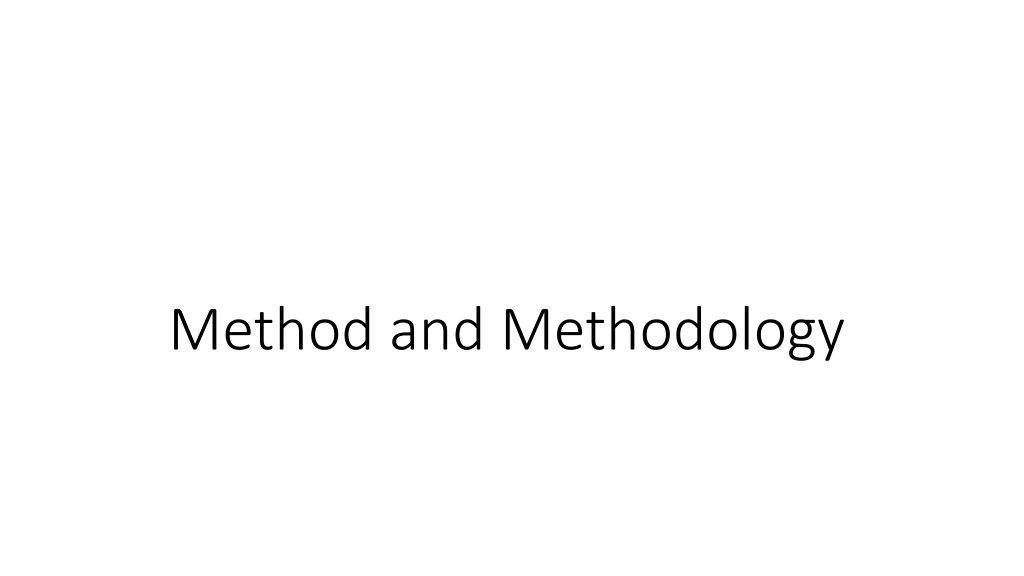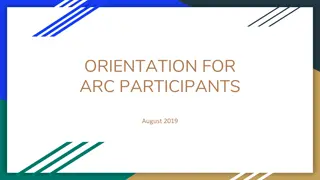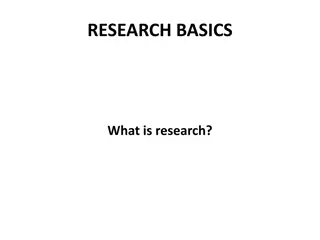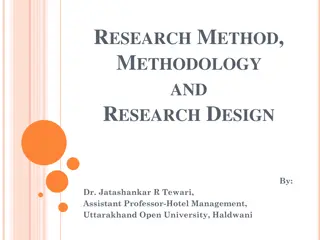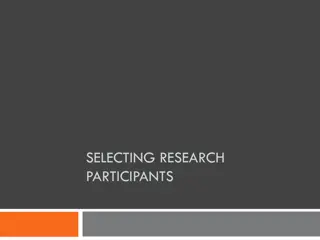Understanding Research Methods and Participants
Explore the differences between method and methodology, types of research methods and methodologies, characteristics of participants in studies, and inclusion/exclusion criteria. The content elaborates on the importance of rationale, justification, and techniques/tools used in research, along with examples and explanations of different types of research approaches. It also discusses various research methodologies such as historiography, ethnography, phenomenology, grounded theory, and ethnomethodology. Moreover, it highlights the significance of participant characteristics, sample sizes, and criteria for inclusion and exclusion in research studies.
Download Presentation

Please find below an Image/Link to download the presentation.
The content on the website is provided AS IS for your information and personal use only. It may not be sold, licensed, or shared on other websites without obtaining consent from the author. Download presentation by click this link. If you encounter any issues during the download, it is possible that the publisher has removed the file from their server.
E N D
Presentation Transcript
Method vs Methodology Methodology - Qualitative Research Method- Quantitative Research Describes the techniques/tools used to collect the data Detailed enough for a good researcher to be able to replicate a study from reading a method section Rationale for the research approach Justification of approach to a research problem through logic and assumptions
Types of Method Types Description Library based Research 1) Analysis of documents- statistical analysis Field based Research 2) Personal, Focused and Group Interview- open and closed questions 3) Survey- Mail and Telephone 4) Non-participant direct observation 5) Participant observations- Recording, everyday observations Laboratory based Research Small group, controlled environment- Use of device to record data
Types of Methodology Types Description Historiography Writing of history based on critical examination of sources into a narrative Ethnography Explores the social world or culture, shared beliefs and behaviors Describes the lived experience of a particular phenomenon Phenomenology Grounded theory Ethnomethodology Use an inductive approach to develop new theory Examine how people use dialogue and body language to construct a world view
Participants Who was in the study? How many participants? Sample size Any important characteristics? Both men and women? Race/Ethnicity? Age group?
Participants Inclusion characteristics Exclusion characteristics Studies must clearly state if participants had to have any characteristics or meet certain requirements Must have a diagnosis Must be a parent-child pair Must be married Must be of a certain income range Must be African American Studies need to state clearly any exclusion characteristics or things that would mean that someone should not be in the study Must not have a serious alcohol or drug problem
The Participants Section-Example Participants Participants were 239 (40 men and 199 women) undergraduates at a university in the Southeastern U.S. who completed a survey in exchange for credit toward a course requirement. Participants median age was 21, and they described themselves as White (55.6%), Black (18.8%), Latino/a (10.4%), Multiracial (5.4%), Asian (4.6%), Arabic (1.3%), and Other (3.8%). Because we focused here on an identity (nerd) whose cross-cultural and cross-linguistic generalizability was unknown to us, we restricted eligibility to native English speakers. Participation in this study was on a voluntary basis. Compensation in the form of extra credit and course credit for academic coursework was provided for some participants enrolled in specific undergraduate college courses. Participants who failed the manipulation check (n = 22) were excluded in further analyses.
The Participants -Example Sample size? Participants Who were the participants? Participants were 239 (40 men and 199 women) undergraduates at a university in the Southeastern U.S. who completed a survey in exchange for credit toward a course requirement. Participants median age was 21, and they described themselves as White (55.6%), Black (18.8%), Latino/a (10.4%), Multiracial (5.4%), Asian (4.6%), Arabic (1.3%), and Other (3.8%). Because we focused on an identity whose cross-cultural and cross- linguistic generalizability was unknown to us, we restricted eligibility to native English speakers. Participation in this study was on a voluntary basis. Compensation in the form of extra credit and course credit for academic coursework was provided for some participants enrolled in specific undergraduate college courses. Participants who failed the manipulation check (n = 22) were excluded in further analyses. Important Characteristics? Inclusion Characteristics? What compensation they received? Exclusion characteristics? How many participants you did not analyze and why?
Study Area Location detail Google Earth/Map GPS coordinates
Materials All materials utilized for the study Which ones were used? Why was it chosen? testing instruments, books, images, database or other materials used in the course of research Measures (Surveys/Interviews/observations) used for the study must provide details about the measures, scale, interpretation of scores When using a pre-existing published measure: Include full name of measure followed by abbreviation and citation of original author Ex: Occupational Stress Indicator (OSI; Cooper, 1997) After that, you can call it the OSI
Materials Drugs, Chemicals , Samples Generic name, manufacturer, purity, concentration. Eg. standards, dyes Culture Media, buffers Components and their concentrations, pH etc. Eg. Phosphate buffer pH 7 Experimental Materials Eg. Tissue, cell line etc.
Materials Animals/Plants/Bacteria State the species, weight, strain, sex, and age etc. Handling and care Details of sedation: agent used, amount, route, administration (single, continuous) etc.
Procedures Sequences of procedures that make up an experiment (Tell a story) Arrange them in sub headings
Experimental design 1. Independent variables Variables manipulated (treatments) 2. Dependent variables Variables measured 3. Control experiments or procedures 4. How many trials/replicates
Experimental Design Example Design conditions for 2 x 2 mixed-model ANOVA. Gender (male, female) was the between-subjects factor and Body type (thin, heavy) was the within-subjects factor. The rejection level for all analyses was set at p = 0.05. The data were collected in four experimental Describes the experimental design, with factors, levels, and type of factor.
Data Analysis Simple test- Mean, standard deviation (SD), standard error of the mean (SEM) Statistical tests e.g. ANOVA, regression, descriptive statistics, t-tests, Chi square etc. Instrument e.g. HPLC analysis (solvent, method, flow rate, temperature, column etc)
Data Analysis Example All qPCR and transfection data were subjected to one-way ANOVA, and differences between individual means were tested by a Tukey multiple- range test using Prism version 4.0 software (GraphPad). Tests of significance were performed using the appropriate error terms according to the expectation of the mean squares for error. A P value of 0.05 or less was considered significant. Data are presented as least- square means SEM.
